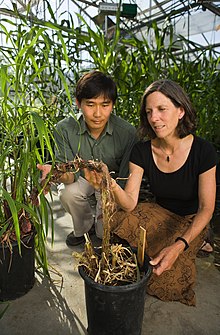Sarah Hake
Sarah Hake is a plant developmental biologist who directs the USDA's Plant Gene Expression Center in Albany, CA.[3] In 2009 she was elected a fellow of the American Association for the Advancement of Science and elected member of the National Academy of Sciences.[4]
Sarah Carter Hake PhD | |
|---|---|
 Sarah Hake and her former postdoc George Chuck examine a corn plant. | |
| Nationality | United States |
| Education | Grinnell College, Washington University |
| Known for | Cloning knotted1 a founding member of the homeobox gene family.[1] |
| Spouse(s) | Don[2] |
| Awards | Stephen Hales prize |
| Scientific career | |
| Fields | Plant Biology |
| Institutions | USDA |
| Thesis | The genome of Zea mays : its organization and homology to related grasses (1980) |
| Doctoral advisor | Virginia Walbot |
| Website | pgec |
Early life and education
Hake lived in Iowa until she was 10 years old and then moved to California. She attended Grinnell College, graduating in 1975.[3] As an undergraduate she accompanied a professor to the Botanical Garden in St. Louis which convinced her to study plant biology.[2] After working as a waitress for a year after college, she was accepted into the PhD program at Washington University in St. Louis where she completed her PhD with Virginia Walbot,[5] studying, among other things, the proportion of the DNA in the maize genome which was present as multiple copies.[2] She met Michael Freeling when she was a graduate student and, impressed by research which considered outside the range of traditional genetic research at the time, wrote an NIH proposal to work as a postdoc in his lab at the University of California, Berkeley cloning the gene ADH1.[2] After cloning the ADH1 gene, Hake and Freeling wrote and received a second grant to clone the Knotted1 gene,[2] which they succeeded in doing in 1989.[6]
After completing her postdoc she was hired as a principal investigator at the USDA Plant Gene Expression Center in Albany, CA. She currently serves as the director for the Center and is an adjunct professor in the Department of Plant and Microbial Biology at the University of California, Berkeley.[3]
Research
Hake considers her single most important scientific contribution to be the cloning of Knotted1 the first cloned plant gene with an effect on development.[5][1] Postdocs working in her lab have gone on to clone other genes controlling maize development including terminal ear1[7], barren inflorescence2[8], fasciated ear2[9], tangled[10], and indeterminate spikelet1.[11][5]
Recognition
- In 2007 Hake received Stephen Hales prize from American Society of Plant Biologists.[12]
- In 2009 Hake was elected a fellow of the American Association for the Advancement of Science.[13]
- In 2009 Hake was elected to the National Academy of Sciences.[4]
Personal life
Hake has two children born while she was a postdoc.[5] Since she was a postdoc at UC-Berkeley, Hake and her family live on the Gospel Flat Farm near Bolinas, California.[2]
References
- Vollbrecht, Erik; Veit, Bruce; Sinha, Neelima; Hake, Sarah (1991). "The developmental gene Knotted-1 is a member of a maize homeobox gene family". Nature. 350 (6315): 241–243. Bibcode:1991Natur.350..241V. doi:10.1038/350241a0. PMID 1672445. S2CID 4328310.
- https://nature.berkeley.edu/news/2019/09/plant-biologist-farmer-and-grandmother-interview-sarah-hake
- https://plantandmicrobiology.berkeley.edu/profile/hake
- http://www.nasonline.org/member-directory/members/20017189.html
- https://aspb.org/wp-content/uploads/2020/03/Legacy-Society-Founding-Members-Sarah-Hake.pdf
- Hake, Sarah; Vollbrecht, Erik; Freeling, Michael (1989). "Cloning Knotted, the dominant morphological mutant in maize using Ds2 as a transposon tag". The EMBO Journal. 8 (1): 15–22. doi:10.1002/j.1460-2075.1989.tb03343.x. PMC 400767. PMID 16453866.
- Veit, Bruce; Briggs, Steven P.; Schmidt, Robert J.; Yanofsky, Martin F.; Hake, Sarah (1998). "Regulation of leaf initiation by the terminal ear 1 gene of maize". Nature. 393 (6681): 166–168. Bibcode:1998Natur.393..166V. doi:10.1038/30239. PMID 9603518. S2CID 205000323.
- McSteen, P.; Hake, S. (2001). "Barren inflorescence2 regulates axillary meristem development in the maize inflorescence". Development (Cambridge, England). 128 (15): 2881–91. PMID 11532912.
- Taguchi-Shiobara, F.; Yuan, Z.; Hake, S.; Jackson, D. (2001). "The fasciated ear2 gene encodes a leucine-rich repeat receptor-like protein that regulates shoot meristem proliferation in maize". Genes & Development. 15 (20): 2755–2766. doi:10.1101/gad.208501. PMC 312812. PMID 11641280.
- Smith, L. G.; Hake, S.; Sylvester, A. W. (1996). "The tangled-1 mutation alters cell division orientations throughout maize leaf development without altering leaf shape". Development (Cambridge, England). 122 (2): 481–9. PMID 8625799.
- Chuck, G.; Meeley, R. B.; Hake, S. (1998). "The control of maize spikelet meristem fate by the APETALA2-like gene indeterminate spikelet1". Genes & Development. 12 (8): 1145–1154. doi:10.1101/gad.12.8.1145. PMC 316712. PMID 9553044.
- https://aspb.org/awards-funding/aspb-awards/stephen-hales-prize/#tab-id-3
- https://www.aaas.org/fellows/historic
External links
- Sarah Hake publications indexed by Google Scholar